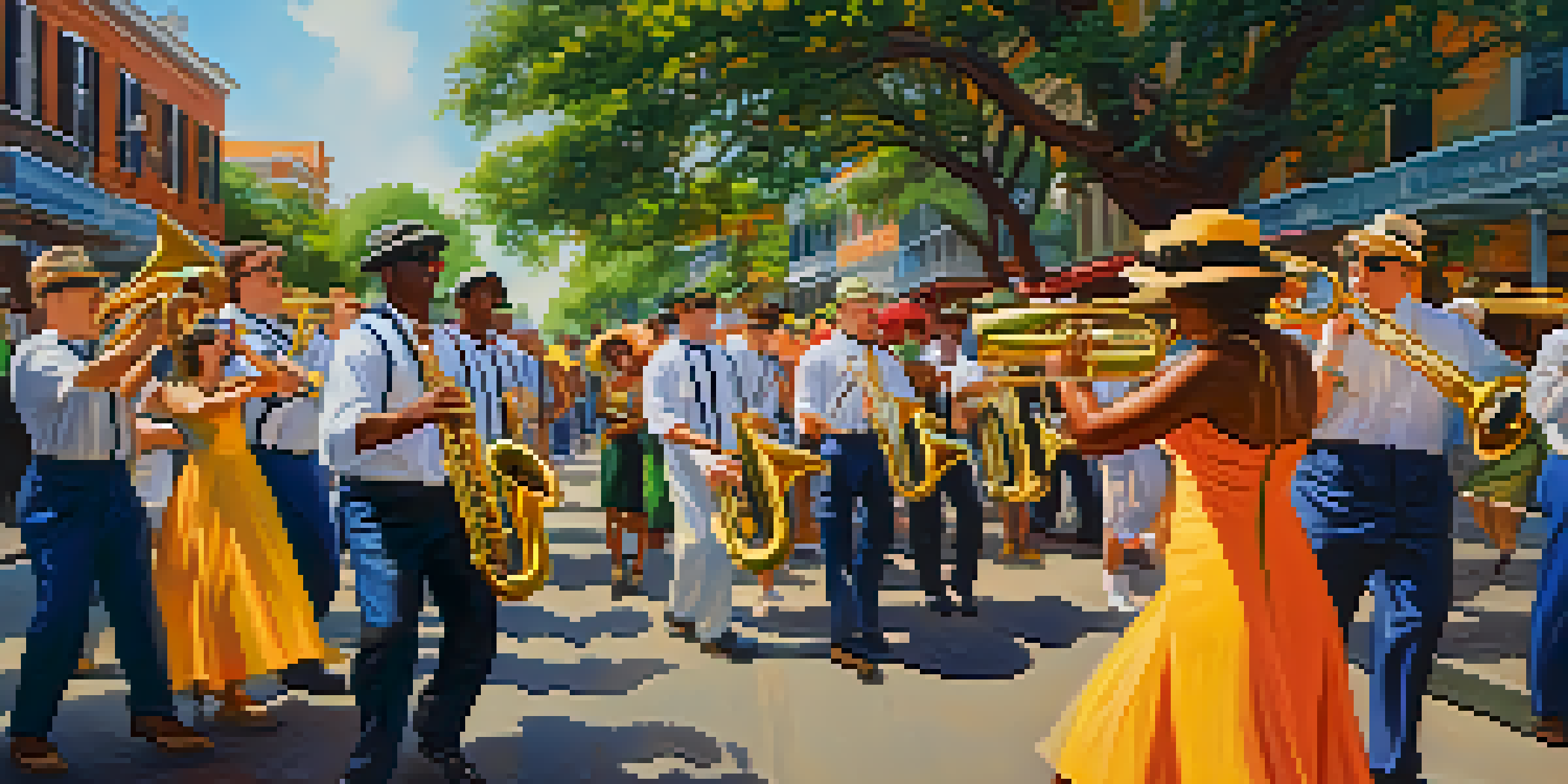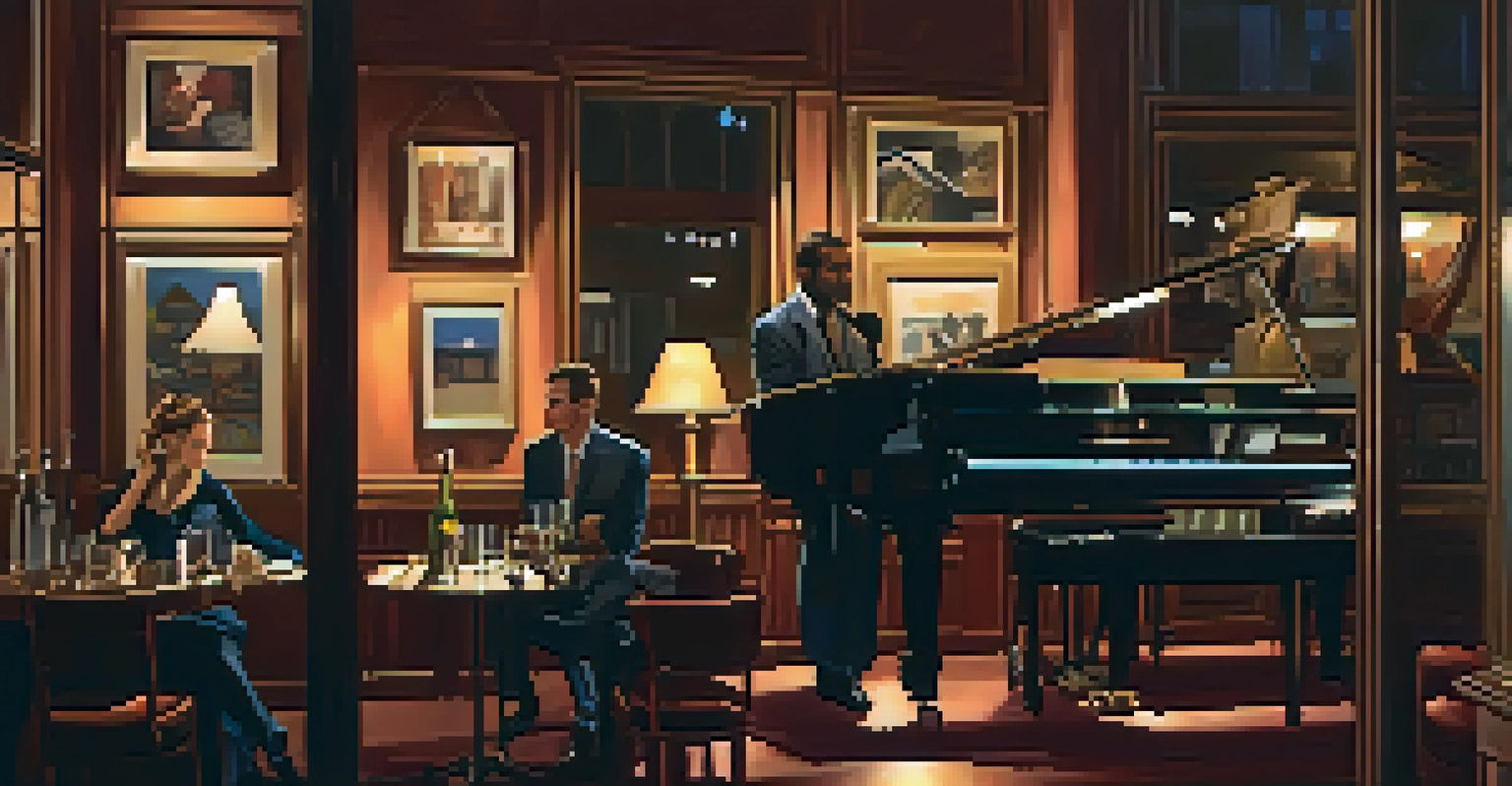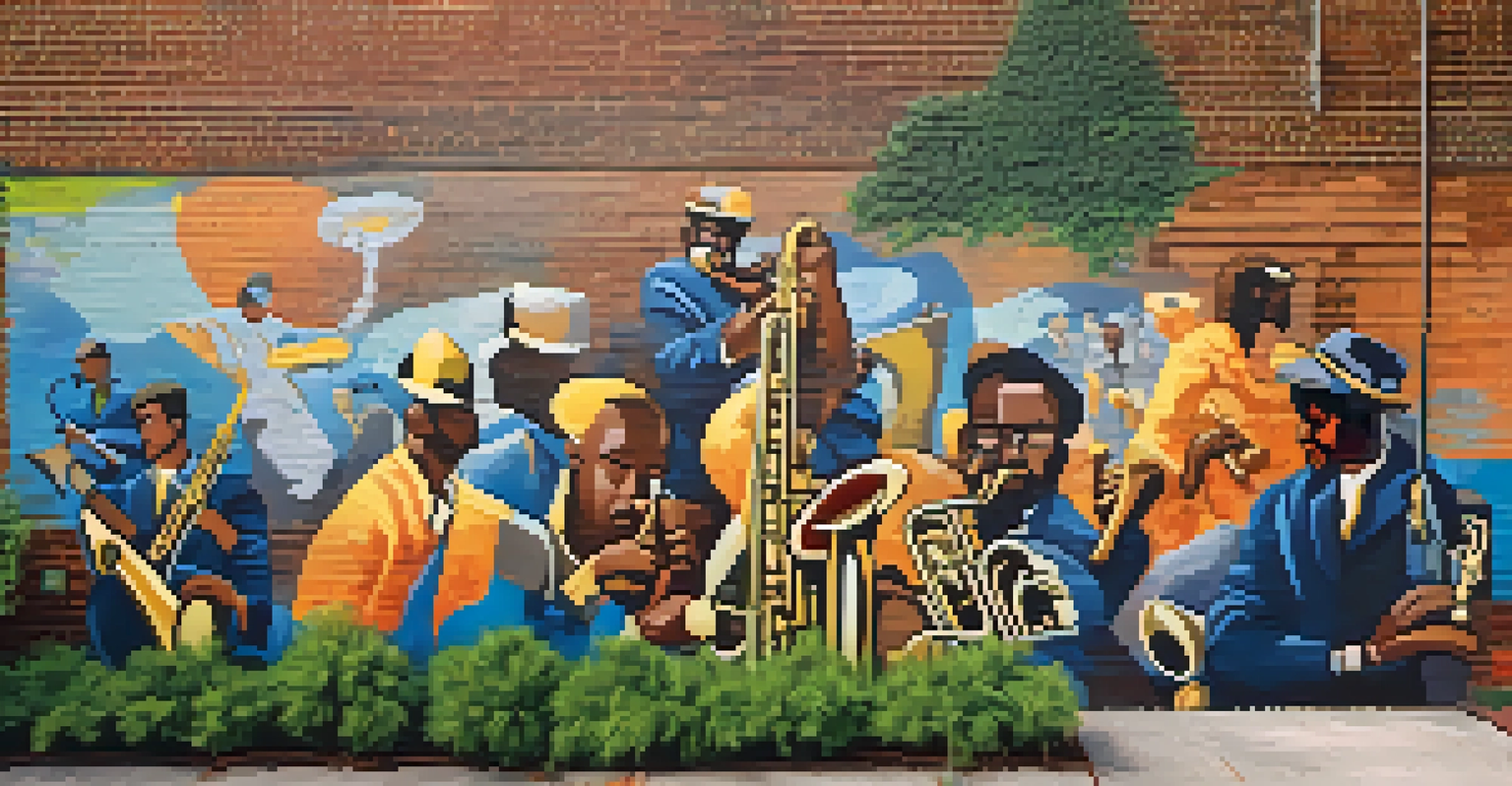The Impact of Jazz on New Orleans Literature and Art

Jazz: The Heartbeat of New Orleans
Jazz is more than just music in New Orleans; it’s the pulse of the city. Born in the early 20th century, this genre reflects the rich cultural tapestry of the region. The blend of African, French, Spanish, and Creole influences creates a unique sound that resonates with locals and visitors alike. It's this vibrant backdrop that fuels the imagination of artists and writers in the city.
Jazz is the voice of the people; it is the music of the soul and the heart of New Orleans.
As jazz musicians improvise, they tell stories that echo the experiences of the community. This improvisational spirit extends beyond music, influencing poets, novelists, and visual artists. Just like a jazz solo, literature and art in New Orleans often embrace spontaneity, allowing creators to express their truths in dynamic ways. The rhythm and flow of jazz become a metaphor for the creative process itself.
In New Orleans, jazz is often a communal experience, much like storytelling. Artists gather in cafés and on street corners, sharing their work and sparking inspiration in one another. This sense of community fosters collaboration and innovation, leading to a flourishing artistic scene that continues to thrive today.
Jazz’s Influence on Literary Themes
Jazz has profoundly shaped the themes found in New Orleans literature, often reflecting the struggles and triumphs of its people. Writers like Louis Armstrong and Zora Neale Hurston infused their work with the sounds and rhythms of jazz, capturing the essence of the era. The themes of improvisation, freedom, and resilience echo throughout their narratives, just as they do in jazz music.

Additionally, the narrative structures of many New Orleans novels mirror the improvisational nature of jazz. Authors employ stream-of-consciousness techniques, creating a flow that mimics the spontaneity of a jazz performance. This style invites readers to experience the story as if it were a musical composition, enhancing emotional engagement and connection.
Jazz Shapes New Orleans Culture
Jazz serves as a vital expression of cultural identity in New Orleans, influencing art, literature, and community engagement.
Moreover, the lyrical quality of jazz often inspires poets to explore language in innovative ways. The cadence and musicality of jazz become tools for poets, enabling them to convey complex emotions and vivid imagery. This interplay between music and poetry enriches the literary landscape of New Orleans, making it a unique cultural hub.
Visual Arts and the Jazz Aesthetic
The influence of jazz extends into the visual arts, inspiring artists to explore movement, color, and emotion. Just as jazz musicians play with dynamics and tempo, painters and sculptors experiment with form and texture to evoke a similar feeling. The vibrant colors of a jazz performance can be seen in the works of artists like Jean-Michel Basquiat, whose pieces often embody the energy of the music.
The beauty of jazz is that it allows for spontaneity; it reflects the constant change of life itself.
Jazz also serves as a subject matter for many visual artists, who capture scenes of musicians in action or the lively atmosphere of jazz clubs. These artworks not only celebrate the music itself but also reflect the cultural significance of jazz in New Orleans. By immortalizing these moments, artists contribute to the ongoing narrative of jazz as a vital part of the city’s identity.
Furthermore, the improvisational spirit of jazz influences the creative process in visual arts, encouraging spontaneity and experimentation. Artists may find themselves drawing inspiration from the rhythms and melodies of jazz, allowing their work to evolve organically. This synergy between music and visual art showcases the interconnectedness of creative expression in New Orleans.
Jazz as a Catalyst for Cultural Identity
In New Orleans, jazz is a powerful tool for expressing cultural identity, particularly among marginalized communities. It provides a voice for those who have historically been silenced, allowing them to share their stories and experiences. The music, rooted in African American history, becomes a means of reclaiming agency and celebrating heritage.
Jazz festivals and events further reinforce this cultural identity, bringing together diverse groups to celebrate their shared love for the music. These gatherings foster a sense of belonging and community, where individuals can connect through their appreciation for jazz. In this way, jazz transcends mere entertainment; it becomes a symbol of unity and pride.
Improvisation Drives Artistic Innovation
The improvisational nature of jazz encourages artists across various disciplines to experiment and push creative boundaries.
As writers and artists draw from the rich tapestry of jazz, they contribute to a narrative that honors their cultural roots. This ongoing dialogue between music and art creates a dynamic space for cultural expression, ensuring that the voices of New Orleans continue to resonate through time.
Jazz and the Evolution of Modern Art
The impact of jazz on modern art in New Orleans cannot be overstated. As artists embrace the principles of improvisation, they push the boundaries of traditional forms, resulting in innovative creations. This evolution reflects the ever-changing nature of jazz music, which constantly adapts and reinvents itself.
Contemporary artists often draw inspiration from jazz legends, using their stories and musical styles as a foundation for their work. This homage to the past creates a bridge between generations, allowing the legacy of jazz to influence the next wave of creators. The result is a diverse array of artistic expressions that honor the roots of jazz while exploring new avenues.
Moreover, the intersection of jazz and modern art fosters a dialogue about social issues, encouraging artists to address themes of race, identity, and resilience. This synergy enriches the cultural landscape of New Orleans, making it a vibrant hub for artistic experimentation and social commentary.
The Role of Jazz in Community Engagement
Jazz plays a significant role in community engagement in New Orleans, bringing people together through shared experiences. Local musicians often perform in public spaces, creating an inclusive environment where everyone can participate. These performances transform streets and parks into vibrant gathering spots, fostering a sense of belonging among residents.
Furthermore, community organizations often utilize jazz as a means of outreach and education. Programs that teach young people about jazz history and performance not only preserve the genre but also empower the next generation of artists. By engaging with their cultural heritage, these individuals develop a sense of pride and identity tied to the rich tradition of jazz.
Community Bonded Through Jazz
Jazz fosters a sense of belonging and unity among residents, enriching community ties and promoting resilience through shared experiences.
As communities come together to celebrate jazz, they also strengthen their bonds and foster resilience. The collective experience of music-making and appreciation reinforces social ties, creating a supportive network that nurtures creativity. In this way, jazz serves as both a cultural cornerstone and a catalyst for community development.
Preserving the Legacy of Jazz in Arts
Preserving the legacy of jazz in literature and art is crucial for future generations. As the genre continues to evolve, it’s important to document and celebrate its rich history and influence. Institutions like the New Orleans Jazz Museum play a vital role in this preservation, showcasing the works of artists and writers inspired by jazz.
Moreover, artists and writers are increasingly collaborating to create interdisciplinary projects that honor the legacy of jazz. These initiatives not only highlight the interconnectedness of different art forms but also ensure that the stories and sounds of jazz remain alive. By fostering collaboration, the community can create a dynamic platform for dialogue and exploration.

As we look to the future, the challenge lies in maintaining the authenticity of jazz while embracing new interpretations. By valuing the contributions of both established and emerging artists, New Orleans can continue to be a beacon of creativity and cultural expression, rooted in the transformative power of jazz.